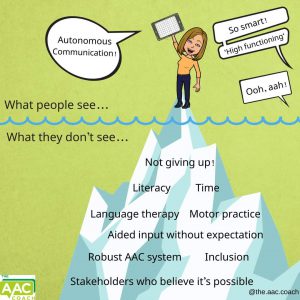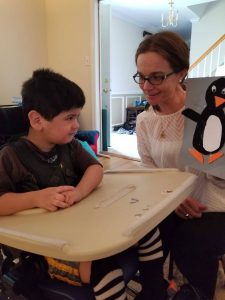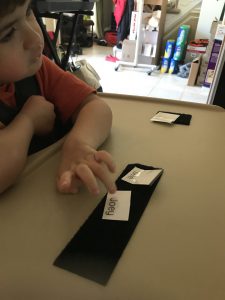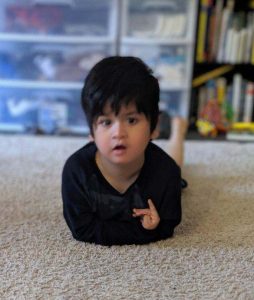 This picture from AAC Coach says so much about the nature of success with communication when using AAC. A few years ago I chatted with a college student who was able to fluidly answer my questions while typing on her iPad. It seemed impossible the story she was sharing was true – that until middle school she had been treated as though she had a significant intellectual disability, denied access to inclusive classrooms, and overheard teachers making comments that her parents “should just institutionalize her”. Yet here was this put together, bright college student who only stuck out because she typed her replies to me instead of speaking them aloud. It would be easy to assume from that conversation that all she needed was typing lessons and an iPad – but it is so much more than that.
This picture from AAC Coach says so much about the nature of success with communication when using AAC. A few years ago I chatted with a college student who was able to fluidly answer my questions while typing on her iPad. It seemed impossible the story she was sharing was true – that until middle school she had been treated as though she had a significant intellectual disability, denied access to inclusive classrooms, and overheard teachers making comments that her parents “should just institutionalize her”. Yet here was this put together, bright college student who only stuck out because she typed her replies to me instead of speaking them aloud. It would be easy to assume from that conversation that all she needed was typing lessons and an iPad – but it is so much more than that.
Wait Time Over Zoom
 Wait time is one of the most vital supports we can give a child (or an adult). I’ve written about it numerous times on this blog. While it doesn’t involve any extra supports, gadgets, or tools, it is still recognizably hard to do. We, as teachers and parents, aren’t good at waiting.
Wait time is one of the most vital supports we can give a child (or an adult). I’ve written about it numerous times on this blog. While it doesn’t involve any extra supports, gadgets, or tools, it is still recognizably hard to do. We, as teachers and parents, aren’t good at waiting.
We aren’t good at providing enough in-person waiting time. Now that we are doing most of our work on-line, wait time is even more complicated. Not only do we need to wait to provide our students with the same processing time they need to respond in our in-person work, now we also have to account for a computer delay, the time it may take a child to unmute or speak into the computer, or to process the additional virtual and auditory information coming from the computer screen while shutting out the in-person visual/auditory information coming from real life.
Getting Joey Reading
 Joey continues to impress us with his strong visual memory. It seems as though I can introduce a sight word to him once, and he will soon be able to find it from a field of six. His ability to receptively identify these words in isolation continues to impress me. So we know he is able to recognize words. How do we get him from reading these words to reading and understanding what he reads? How do we measure that? How do we know when he is achieving it and it is time to increase the level of the work we give him?
Joey continues to impress us with his strong visual memory. It seems as though I can introduce a sight word to him once, and he will soon be able to find it from a field of six. His ability to receptively identify these words in isolation continues to impress me. So we know he is able to recognize words. How do we get him from reading these words to reading and understanding what he reads? How do we measure that? How do we know when he is achieving it and it is time to increase the level of the work we give him?
One way I am working to make leveled guided reading books available to him is to use the on-line books offered from Pioneer Valley press. These books allow me to put Joey’s name into the book (giving him an anchor word on each page), and to print the books out at home. Although Joey and I can take turns reading each page of these books, using his device is laborious when matching each word, and he often makes mistakes, not because of his ability to recognize the word, but in his ability to maintain the motor control of his neck and to select the correct word. In short, it’s exhausting and no fun.
Measuring Joey’s Progress

As Joey begins accessing more academic content, we are constantly attempting to assess how we can best measure his knowledge. Taking all of the potential drawbacks of the AAC device into account, how do we make sure we are measuring the pure academic skills instead of simply measuring his academic skills in relation to the AAC device?
This is a tricky line that many families and educators whose children use AAC devices walk daily. It is a decision point that we make when we ask someone who uses an AAC what they want to do next, and we watch to see if they seem confident with their answer to our question, or if they seem frustrated because they hit an incorrect icon. It takes understanding and professional judgment on the part of the communication partner. [Read more…]
Continuing to Presume Competence and Looking Beyond Behaviors
 One day I came in for a session with Joey and it felt as though I was engaging with another student. He couldn’t take his eyes off his screen, and rapidly fired words at me over and over again. If the words were connected I couldn’t follow his message, and if he asked me questions he did not wait for a response. It was so unlike him and I couldn’t stop wondering what was going on.
One day I came in for a session with Joey and it felt as though I was engaging with another student. He couldn’t take his eyes off his screen, and rapidly fired words at me over and over again. If the words were connected I couldn’t follow his message, and if he asked me questions he did not wait for a response. It was so unlike him and I couldn’t stop wondering what was going on.
I kept trying to get his attention, slow him down, and ask him to pause and look at me, but he wouldn’t – word after word spurted out of the device – so quickly that I couldn’t even collect my traditional data. What was happening here? I heard this is what he was doing in school as well, and I started to question everything I’ve ever done with Joey. Was he really able to use his device to speak, or was it all just coincidence until he gained this rapid fire ability and now he just strung words together, showing us he never understood anything to begin with? [Read more…]
- « Previous Page
- 1
- 2
- 3
- 4
- 5
- …
- 11
- Next Page »


